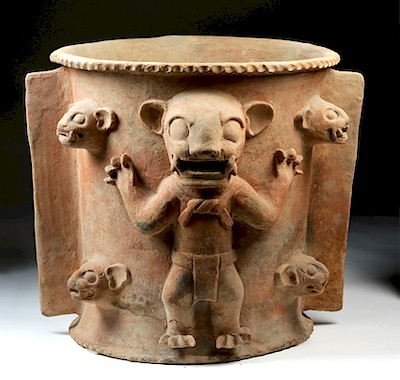Jalisco Polychrome Seated Warrior Figure - ex-Hollywood
Lot 109d
About Seller
Artemis Fine Arts
686 S Taylor Ave, Ste 106
Louisville, CO 80027
United States
Selling antiquities, ancient and ethnographic art online since 1993, Artemis Gallery specializes in Classical Antiquities (Egyptian, Greek, Roman, Near Eastern), Asian, Pre-Columbian, African / Tribal / Oceanographic art. Our extensive inventory includes pottery, stone, metal, wood, glass and textil...Read more
Estimate:
$4,500 - $6,750
Absentee vs Live bid
Two ways to bid:
- Leave a max absentee bid and the platform will bid on your behalf up to your maximum bid during the live auction.
- Bid live during the auction and your bids will be submitted real-time to the auctioneer.
Bid Increments
| Price | Bid Increment |
|---|---|
| $0 | $25 |
| $300 | $50 |
| $1,000 | $100 |
| $2,000 | $250 |
| $5,000 | $500 |
| $10,000 | $1,000 |
| $20,000 | $2,500 |
| $50,000 | $5,000 |
| $100,000 | $10,000 |
| $200,000 | $20,000 |
About Auction
By Artemis Fine Arts
Dec 6, 2018
Set Reminder
2018-12-06 10:00:00
2018-12-06 10:00:00
America/New_York
Bidsquare
Bidsquare : DAY 2 : Pre-Columbian, Ethnographic & Fine Art
https://www.bidsquare.com/auctions/artemis-gallery/day-2-pre-columbian-ethnographic-fine-art-3699
Day 2 of an important 2-dy auction featuring ancient and ethnographic art from around the world. Today's sale will feature Pre-Columbian, Native American, African / Tribal, Ethnographic, Spanish Colonial, Fine Art, much more. Artemis Fine Arts info@artemisgallery.com
Day 2 of an important 2-dy auction featuring ancient and ethnographic art from around the world. Today's sale will feature Pre-Columbian, Native American, African / Tribal, Ethnographic, Spanish Colonial, Fine Art, much more. Artemis Fine Arts info@artemisgallery.com
- Lot Description
Pre-Columbian, Western Mexico, Jalisco, ca. 300 BCE to 300 CE. A wonderful pottery example of a male San Sebastian warrior figure. The statue is seated, with bent legs and delineated genitalia, his portly abdomen tracing upwards to a wide chest and rounded shoulders, one of which bears several raised discs indicative of ritual scarification. His left hand firmly grasps an olla intended for holding blood, and his right holds the handle of a formidable club which rests atop his shoulder. An elongated head boasts a visage comprised of almond eyes, a prominent nose, parted lips, broad ears with several earrings each, and a tall brow, all capped with a simple pinched cap. Black scarification marks are painted across his face and lips, with three lengthy bands extending down onto his chest. The club, neck line, and lower body are all colored with an umber slip atop a cream ground, making this an elegant example from ancient Western Mexico! Size: 9.5" W x 14.75" H (24.1 cm x 37.5 cm).
Clay figures like this example are the only remains that we have today of this sophisticated and unique culture in West Mexico. The indigenous made no above-ground monuments or sculptures, at least that we know of, which is in stark contrast to developments elsewhere in ancient Mesoamerica. Instead, they developed a widely-used method of burial known as shaft tombs.
The dead were buried down shafts - 3 to 20 meters deep - that were dug vertically or near vertically through “tepetate” - the volcanic tuff that makes up the geology of the region. The base of the shaft would open into one or more horizontal chambers with a low ceiling. These shafts were almost always dug beneath a dwelling, probably a family home, and seem to have been used as family mausoleums, housing the remains of many related individuals. Their tombs were their lasting works of art: skeletons arrayed radially with their feet positioned inward, and clay offerings, like this one, placed alongside the walls facing inward, near the skulls.
This is a figure made to be placed inside those mausoleums, perhaps to mediate between the worlds of the living and the dead. However, we unfortunately lack the information we would need to understand what these figures were truly made for. Do they represent everyday people, even individuals? Are they religious? Were they created to mediate between the living and the dead? Whatever their purpose, today they are beautiful artwork and reminders of the mysterious past.
Provenance: private Hawaii, USA collection; ex-private T. Misenhimer collection, Hollywood, California, USA, famous Hollywood film producer; ex-private Arizona, USA collection
All items legal to buy/sell under U.S. Statute covering cultural patrimony Code 2600, CHAPTER 14, and are guaranteed to be as described or your money back.
A Certificate of Authenticity will accompany all winning bids.
We ship worldwide and handle all shipping in-house for your convenience.
#133782Figure repaired from multiple pieces with some restoration, overpainting, and resurfacing along break lines. Surface wear and abrasions commensurate with age, small chips and nicks to feet, base, body, head, and club, with some discoloration and fading to pigmentation. Nice earthen and mineral deposits throughout with root marks along base.Condition
- Shipping Info
-
All shipping is handled in-house for your convenience. Your invoice from Artemis Gallery will include shipping calculation instructions. If in doubt, please inquire BEFORE bidding for estimated shipping costs for individual items.
-
- Buyer's Premium



 EUR
EUR CAD
CAD AUD
AUD GBP
GBP MXN
MXN HKD
HKD CNY
CNY MYR
MYR SEK
SEK SGD
SGD CHF
CHF THB
THB

















